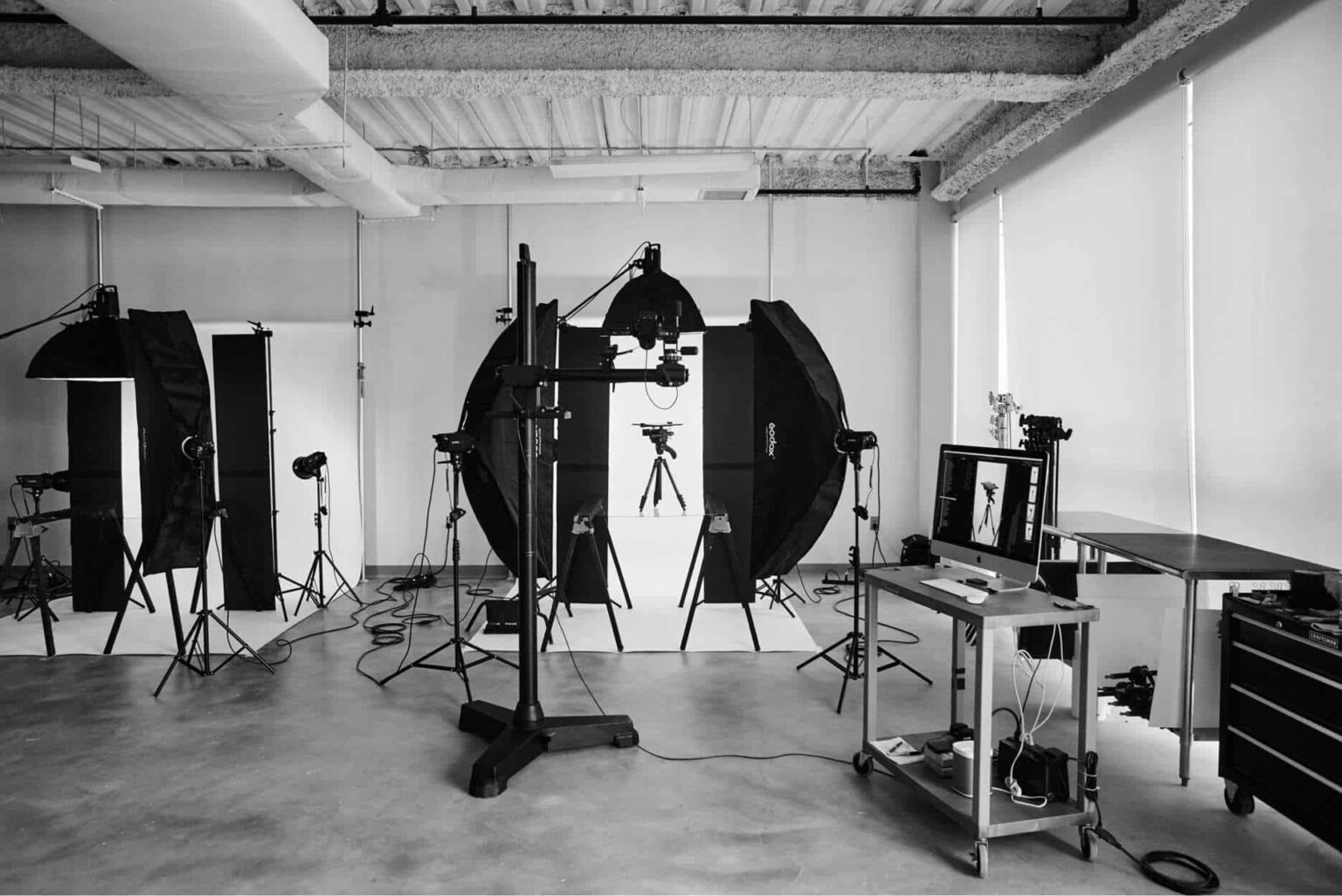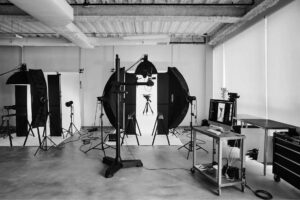What is ecommerce photography?
Ecommerce Product photography is an essential element of e-commerce. For this reason, product photos must be appealing and accurate. By meeting these two criteria, you can create the shopping experience your customers are looking for. You can’t go wrong with high-quality product photos.
They make your website more attractive and increase the likelihood of a purchase – good images can only enhance your online presence. Not surprisingly, there are many factors to consider when taking e-commerce photos. In this article, we’ll go over the best practises for capturing the beauty of your products and share some of our best insider ecommerce photography tips. Enjoy!
The short history of still life photography
It all started with the curiosity to discover more about the surrounding objects. I highly recommend you to watch this documentary describing the entire journey of still life photography, in credible details. The movement that set the scene for eCommerce product photography and the still life genre can be traced down to the early 17th century.
During those days, people were trying to depict day-to-day objects. Still life painters found their inspiration in small and simple products such as flowers, fruits, and vegetables they were surrounded by. This style was a bedrock which simply evolved to commercial product photography later with the rise of new photography medium.
However, this early type of photography had other purposes than what it has today. Back then, scientists were heavily involved in this art for studying purposes. Also, photographers would use this branch of imagery in order to showcase their skills. As the world of art evolved, so did the genre of still life photography.
Early artists relied heavily on painting techniques to create their compositions, but over time they developed their own style. In particular, French photographer Édouard Baldus became known for his exquisitely composed still lifes, which often featured intricate details and beautiful lighting effects.
However, it wasn’t until the early 20th century that photographers began to use still life to sell their products. One of the earliest examples of commercial product photography is a 1927 advertisement for Kodak cameras. Set against a backdrop of various props, including flowers and fruit, the advertisement shows a woman sitting in a studio with a large camera on her lap – “one small step for man, one giant leap for mankind” Today, still life photography is a popular genre used by both amateurs and professional photographers. Let’s find out together why.
Why is good photography important for your e-commerce business?
There’s no question that e-commerce is booming. Global e-commerce experienced another record year in 2021 and is expected to surpass $5.4 trillion in 2022. By 2024, this figure is expected to rise further, reaching 21.8% of total global retail sales, according to Statista. But what role does photography play in this fast-growing industry?
Quite simply, product photography in Los Angeles is essential for entrepreneurs who want to sell their products online. Good photos not only help present your products in the best possible light, but they can also help build trust with potential customers. If buyers can’t touch or feel a product before they buy it, they need to be confident that what they’re seeing is accurate. We provide E-commerce product photography services in Los Angeles, Miami, Chicago, Houston, Atlanta, and San Diego.
Some common mistakes companies make with product photography are using poor quality images, not having enough images of the product, or not photographing the products from all angles. With product photography, it’s important to show your product in the best light.
Types of ecommerce product photography
Everyone wants to sell more. You are sure to increase your likelihood of doing that using at least one of these 3 types of photography: still life, model photography, and CGI.
Still life product photography is the most common. Here, products are photographed in a studio setting against a plain background. The focus is on the object itself and not on the person holding or using it.
If you are selling goods in niches such as fashion or beauty, product photography on the model might be the way to go. This way, you give customers a clearer idea of what the product looks and how they can use it in their lives. The photograph is meant to look natural and perfectly capture the most important aspects of what you are trying to sell. Therefore it is more than crucial to rent the right model.
CGI product photography is a cheaper and higher quality alternative used for products that are too difficult or challenging to photograph in a studio environment. This groundbreaking style of photography stands for Computer Generated Imagery and is designed and orchestrated entirely on a computer.
Traditional e-commerce photography

Traditional studio e-commerce photography is a process of photographing products in a studio environment in order to sell them online. A well-lit studio space with backdrops that can be used for different types of recording is one of the most important assets you need in order to achieve the best possible results.
When using the appropriate props and accessories, you simply can’t go wrong. In studio product photography, professional-quality products are shot in a controlled environment. This type of image creation offers several advantages over other types of product photography, such as shooting on location or in natural light.
The first of many benefits of product photography in the studio is that you are in full control of the most important factor in creating a quality photo – lighting. In the studio you can manipulate it to get any effect you want.
When shooting outside, natural light or weather conditions can affect the look of the photo. This is why you would choose studio photography. You can’t get the same level of control in other environments.
This ensures that all images captured in the studio are consistent in color, composition and style. Let us look at some examples of traditional photography styles.
Traditional photography: white background style
In the world of e-commerce, clean and simple product photography is key to a successful catalog. Against a white background, products can be photographed in their entirety so shoppers can easily see what they’re buying.
People often refer to this type of photography as “white background” or “studio shot”. Product photography with a white background has several advantages. Here are some of them:
- First, it offers you the consistency needed in a catalog, adding a clean and streamlined look to it.
- Second, it shifts the customer’s attention from any unnecessary elements, allowing them to focus on the product itself without distraction.
- Finally, it is essential for picky online shoppers, since you allow them to see all the details of your product when zooming in and out.
In a world of cluttered images and unclear product photos, it’s important that you stand out by keeping things simple and neat. This is why you should strive to achieve a polished and professional e-commerce catalog, using photos with a white background. It’s an obvious, yet rarely used way to differentiate your website from the competition.
Traditional ecommerce photography: minimalistic style
The balance between simplicity and effectiveness is key, and when it comes to photographing products for an online store, less is often more.
While some photographers find that lots of props and colorful backgrounds can make products stand out, it often results in cluttered and confusing images. We all like to see new and flashy images from time to time, but constantly seeing them can make your website visitor leave faster than you had hoped for.
Getting the basics right will never let you down. Light and shadow are the things you want to always perfect in any picture, and by using them to your advantage, you can create simple yet eye-catching product photos.
A neutral background and pops of color on the products can also help make them stand out. Never forget to use a shallow depth of field to focus on the subject being photographed.
All of these techniques are easy to implement, making minimalistic product photos a cost-effective option for ecommerce stores.
Traditional ecommerce photography: with props
When you’re photographing products to sell online, it’s important that they are aesthetically pleasing. One efficient way to achieve this is by using props.
If your target audience proves to be more on the artsy side, you can easily appeal to them when using some extra accessories. They add a creative touch to photos and make them look more elaborate. This way, you will also increase your product’s attractiveness compared to photos without any special elements. There are many different ways to use props in product photography.
After many years of experimenting with various props, the best ones were proven to be: different backgrounds, people or animals, or everyday objects used in unique ways. Always remember that the possibilities are endless, so be creative and have fun with it!
Another huge upside of using props is that they also help you represent the functionality of your products. If a product can do something cool, show it off in a photo! This allows you to target potential buyers who may not have thought of purchasing the product before – just by demonstrating how it works in imaginative ways.
On model photography

You simply can’t ignore the power of showcasing your product on a mockup – it’s one of the most important aspects of e-commerce photography.
By using a person to present what you’re trying to sell, you can create a sense of realism and believability that photos from other angles just can’t convey. People will identify with your product and imagine themselves using it.
Fashion products are the main example. Since jewelry and watches look very different when shot from numerous angles, using a model on which you can display your products could be the perfect way to go about e-commerce photography. By photographing a model, customers can see the product from all angles and get a better idea of what it would look like in real life.
On top of that, you will position your item as being luxurious and of high quality when you choose model product photography. This cannot be matched by other types of photography.
On model: hand modeling for ecommerce
Ever heard of hand modeling? From eating to doing chores around the house, we all use our hands on a daily basis. Having said that, there are hardly any products we don’t touch or feel. Hand modeling is another product photography option for e-commerce websites, being designed to give the viewer a true sense of what a product would look like once it arrives on their porch.
Now comes one of the most frequent questions regarding hand models: “What do I really need them for?”. The answer is quite simple – they help increase your product’s credibility in the eyes of customers. A good hand model can help give the viewer a sense of scale and make small or delicate products look more impressive. Hand models are primarily used in advertising and marketing campaigns where they can create feelings of familiarity in the viewer or convey a message about the product.
When choosing a model, it’s important that you find someone who looks natural and is comfortable with the product. Having said all that, hiring a professional handheld model can be expensive, but there are ways around this.
One idea would be to ask friends or family members for help. Another practical way to go around the high price of a hand model would be to use a mannequin or a dummy hand just like you would use a prop for your shoot.
Sitting at no.1 in our eyes, the best alternative for a professional model would be to use the recent advancement of photography technology. With the help of the fastest and cheapest alternative in the current market, also known as CGI, you can create and model a human hand, all from the comfort of your own home.
This photography phenomenon allows for results like you have never seen before, all at a faster pace and at a cheaper price. If you have not tried CGI for your business yet, you can learn more about it by clicking here.
On model: lifestyle
Connect your product with people’s lifestyles. Since having a business relies heavily on selling, you have to ask yourself: “If I had the same needs, would I buy my product without seeing how it works?”. The answer is probably no.
It’s common knowledge that in the world of online shopping, customers want to see what they’re buying before they buy it. This is where lifestyle photography comes in handy, being a type of product photography that shows the item in a real environment.
People envision things without paying attention to them. It’s our second nature. When thinking this way, lifestyle photography becomes essential as it allows customers to see the product as they would use it. Lifestyle photos can be used for any type of product, but they’re particularly useful for products intended to be used in everyday life, such as clothing, accessories, and home goods.
Using imagery that people can connect with, you create a richer shopping experience for customers, while also increasing your chances of closing a sale significantly. There are many ways to create lifestyle photos of your products, even with powerful tools such as CGI.
Lifestyle CGI product photography involves photographing real objects in a controlled environment to create a product image that looks like a real photograph. This type of imagery is recommended for e-commerce websites as it produces a realistic picture that is more palatable to customers. They relate more to the new air it brings.
In lifestyle CGI product photography, a scene or backdrop is created in a studio and then the product is added to that scene. After the product is added, the photographer stitches the image together, adjusting the light and shadow until it looks like a real photo.
Now that you’ve heard what CGI has to offer, let’s go into more detail about the various benefits.
CGI photography
The expensive and time-consuming traits of product photography are just the tip of the iceberg. In reality, professional-quality images require even more resources, pushing people to find new and better alternatives. This is where CGI product photography comes in.
CGI (Computer Generated Imagery) is a process that uses computer software to create images or videos. Whether it’s high-end imagery or really sophisticated animations, CGI can do it all. This allows companies to create innovative yet realistic images of their products at any time of the day without the need for a physical shoot.
Thanks to its digital features, you have the power at your fingertips. This means that any change, edit, or update can be done with nothing more than just a few clicks. This flexibility is important for companies that regularly update their product range or sell seasonal items.
Additionally, CGI product photography is a great way to promote your brand – you can create videos, images, and even animations that show in real-time how your products are being used by happy customers.
CGI product photography is affordable and can be done in-house or by a third party. If you love faster, more affordable, and more convenient alternatives, you will enjoy this breakthrough technology. It’s also photorealistic – these days it’s almost impossible to distinguish CGI from traditional photography.
All in all, CGI product photography is perfect for e-commerce businesses thanks to its wide range of possibilities.
Now only one question remains. How do I know what type of CGI photography I need? See for yourself below.
CGI photography: White background
When photographing products for an online store, it’s important to have a pristine white background. For one, this contributes to the clarity of the final image, making it easier for customers to see your product. Also, it’s good to note that people enjoy simple things in this world of flashy designs. This is why you should know that a basic white backdrop could also draw attention to your product.
Traditionally, this was achieved with a white background and studio lighting. However, with the advent of CGI photography, it’s now possible to create a white backdrop in any environment.
The days in which you had to constantly reach out to studios are gone. Product photography no longer has to be limited to a controlled indoor environment with a white background. With the latest technologies, you can create a catalog with any background you want. Even transparent ones that can later be changed to any color in Photoshop.
Have a product that can be a real pain when shooting? The advancement of photography means you no longer need to struggle with such objects. Among other benefits, white background CGI photography is particularly useful for products that are difficult to photograph in a studio. Essentially, with CGI you can create a realistic image that best showcases your products.
CGI photography: minimalistic style
Keeping it simple has huge benefits, even with the help of the latest technology. As things generally evolve, so did the imagery industry. CGI is closer to traditional photography than people might realize, but instead, everything is simulated on a computer.
Minimalist product photography is a great way to show off your creativity and ingenuity. In addition to that, you can also use it to give your products an elegant or timeless look.
Product photography is often seen as a way to present your brand in the best possible light. But often the simplest approach is the most effective. The minimalist technique shows a product in its simplest form, without unnecessary frills. By putting the focus on the item itself, you can create an eye-catching image that draws attention to the item’s design or function.
Few people can make something out of thin air – artists can. Minimalist product photos are a great way to show off your creativity and ingenuity and help you create an elegant and timeless look.
CGI (Computer Generated Imagery) has become a popular solution for minimalistic product photography. With it, artists can create any environment for their product and effortlessly control light and shadow.
CGI photography: with props
In the world of e-commerce, props have proved to be a clever way with which you can improve the overall aesthetic of your picture. Nevertheless, the traditional way of using props is very impractical. From the unreasonable sums of money involved to the huge amount of time it takes to assemble the right accessories, props have become an option people often disregard.
With CGI, however, the sky’s the limit. You can create any type of accessory you can think of in a realistic way, without the need for physical props or a studio. Plus, you can either buy them or create them in 3D, saving you time and money while still providing your customers with high-quality images. Also, there is greater impact of 3D product photography in online e-commerce sales.
One of the most obvious benefits is that you can use it to create a realistic and lifelike product representation. And when trying to showcase a practical product, such as jewelry, cosmetics, or perfume, this feature comes in handy.
Another benefit is that props can be used to create a more realistic scene. For example, in a perfume photoshoot, you can use an outdoor CGI background or show the ingredients used in the perfume or cosmetic product. Props can also help reinforce brand identity by adding elements that are unique to the company.
CGI photography: 3D hand modeling
Hand modeling is another valuable option for product photography in e-commerce, Loss Angeles. When a customer wants to buy something, they want to be able to view the product from all angles. This is particularly important for items worn on or through the body, such as watches or jewelry.
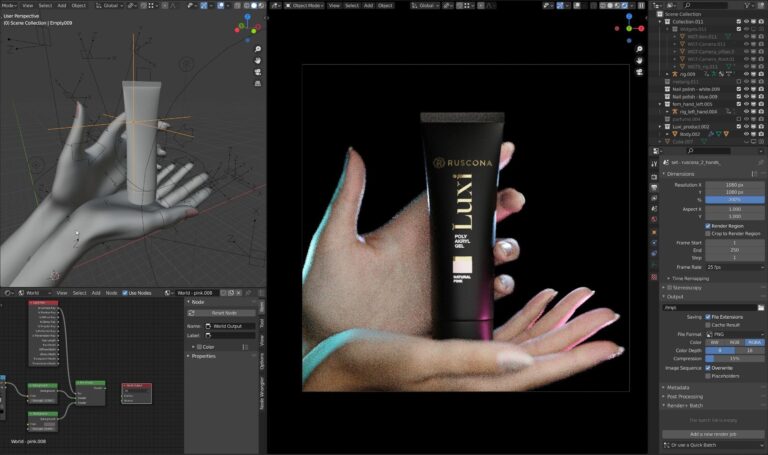
In the past, real people were used for hand modeling. However, this can be expensive and time consuming. Also, finding the right model with the right look can be difficult. Because of this, many companies are now turning to CGI for hand modeling.
An important aspect of using CGI for product photography is a good model of a human hand. Many online stores use stock photos, but this can often look fake or unprofessional.
CGI allows companies to create a 3D rendering of a product held by a photorealistic and recognizable hand that can be viewed from any angle. This gives customers a much more accurate idea of what the product will look like when they receive it.
CGI can also be used to create videos of products being used, which is another great way to show potential customers what to expect.
Product video and 3D animation in ecommerce

To make an informed buying decision, customers want to be able to see and touch the product they’re buying. For products sold online, such as jewelry, accessories or watches, a product video can help bridge the gap between the customer and the product.
Product video
Should you add videos to your website? We say yes! E-commerce product videos are filmed from multiple angles to show all the details. In addition to footage of the product itself, videos may include close-ups of specific features or shots of the product in use. This type of videography is particularly helpful for products that are difficult to put into words, such as furniture or cosmetics.
Because online shoppers can’t touch or examine items before purchasing, a well-made product video can be very reassuring. Customers should see what they’re buying and how it fits into their lives.
3D product animation
Nothing compares to a quality 3D creation. By relying on computer-generated imagery, product animation makes it possible to create a moving product image.
In the world of online sales, you are sure to gain the best possible results by using a website and social media platforms to display your unique animation.
They are used for advertising and marketing and are a great way to showcase a product’s features and benefits in an engaging way.
To put it simply, animations often describe your product to your audience better than static pictures can. In the fast-paced world of e-commerce, they’re an effective way to attract customers and increase sales by being engaging, informative, and easy for customers to engage with.
3D product animations are also a great way to showcase items in new or unique ways, which can be especially helpful for objects that are difficult to photograph or show in person. Additionally, an animated video can add music and/or spoken commentary to further enhance the feel of the product and give it the finishing touch.
The benefits of product animation do not stop there! These jaw-dropping creations can be used to build simple GIFs, also known as stop motion techniques. Animated videos can also be used as part of a larger marketing strategy by embedding them on business websites, social media, and even online shopping carts.
What to consider in preparation for ecommerce photography

You have to understand your customers. When preparing for ecommerce photography, it’s important to consider the needs of your customers and what drives them to buy your products. You need to photograph your products in a way that highlights their features and makes them look appealing.
Always keep in mind that people pay attention to every detail. It’s like they search for reasons to not buy your product. This is why you should strive to make your online appearance look flawless. By using images of high quality you establish a level of trust that is rarely met in mediocre e-commerce websites. Also, models and props are another proven way with which you can show your products in the best light.
Give people a sense of what they’re buying. Incite them to action. For example, if you’re selling a product that needs to be used or touched, such as a piece of furniture, you must ensure that the images show how the product can be used.
Finally, it’s important that you know exactly what your customers are looking for so you can create photos that meet their expectations. Next, we will go over what type of photography you should choose to present your brand in the best possible light.
Traditional vs. CGI photography
Before choosing the right service, ask yourself the question, “What type of product photography is best suited for what type of product?” In general, CGI product photography is best suited for hard surface plastic or metal goods such as jewelry, cosmetics, or perfume packaging.
Products with hard surfaces have a clean, smooth look that can only be enhanced by the revolutionary capabilities of CGI. With this new technology, reflections and highlights can be controlled to achieve the desired effect, whereas using a real model or background can be distracting and doesn’t always give the best results.
Traditional photography is more suited to organic products like food or fashion. Perhaps it’s the imperfections that are often captured, or the way light interacts with natural materials. You can also try the powers of CGI to recreate this feeling, but it can prove to be a bit more time-consuming. If you’re on a tight schedule, you’re better off with traditional photography.
Of course, there are cases where CGI is necessary or preferable – for example, if you want to show a product from an unusual angle or in slow motion, or create a completely artificial environment. But for most organic products, traditional photography is still best. Food or fashion simply look more natural when photographed in the traditional way.
The ever-lasting relationship between Traditional and CGI photography
However, the first breakthrough in still life was a religious work by Duccio, called “The Annunciation”. Amongst other frequently used characters such as angels, a vase of lilies was also depicted. This simple-looking symbol had a life of its own, representing innocence. This was a very important step that led to the further emancipation of what we now call still life photography.
In the present, things are way different. Thanks to years and years of evolution, artists are now able to give objects any nuance they want. Traditional photography is a product of huge sacrifice and study, and so is computer-generated imagery (CGI).
As the first paintings of still life needed religious works in order to exist, the same applies to these two branches of imagery. CGI was built on the shoulders of traditional photography, there’s no denying that. Skilled artists with decades of experience dedicate themselves to bringing your product to life – and their work speaks volumes for them.
Many are quick to judge the fast advancement of photography today, but nobody can deny its helpful features. Take for example CGI. It is the fastest way for people to get their images. Also, it is the cheapest alternative there is – after all, you only need a computer, some reference images, and a colorful imagination.
Now that we talked about the strong relationship between the best ways to create stunning images for your e-commerce website, let’s go into detail about the most important benefits each has.
CGI is closer to the traditional way of capturing images than you might think. Believe it or not, there is more than meets the eye when you think about the evolution of photography. Let’s start with the beginnings of still life photography.
Like many types of art, the still life genre came from religious works. During the early days, artists were hired by the church to create stunning imagery of various passages in the Bible. People were more interested in seeing heavenly figures rather than simple day-to-day objects, being strictly forbidden by the church.
If a painter would use natural elements, it was only in relation to the events in the holy book. For example, the apple, a common object in still life today, was only used to represent humanity’s fall from grace, as it is related to the story of Adam and Eve.
Benefits of traditional photography
If you need to take top-notch photos of products made from organic materials like food or fabrics, there’s no better option than traditional digital e-commercial photography. By hiring a professional photographer with the necessary equipment, you ensure that your products are photographed in the best possible light and with perfect focus so they look their best for online sales.
Traditional digital e-commercial photography still offers many advantages over other methods. For one thing, it’s fast. Why? You can take a large number of photos in a short amount of time, so it’s easy to get the perfect shot.
In addition to that, you have more control over the finished product, and thanks to the numerous digital editing tools, you can polish each image until it’s just right.
In many cases, CGI product photography may not give you the precision and convenience met in traditional shoots, but it’s still a good option for many different products.
Finally, traditional digital e-commercial photography is affordable. Even small businesses can afford to hire a professional photographer to show off their products in the best manner possible.
Benefits of CGI photography
New techniques always bring revolutionary and eye-catching ideas to any industry – CGI being the prime example. The first advantage that crosses the mind is its effectiveness. All you need to bring your ideas into reality is a mobile phone. With CGI, you can photograph your products and send them to a CGI product photography studio to be further mapped and edited.
Also, once you decide to try this new branch of photography, you say goodbye to the time-consuming process of setting up a studio or hiring a model – not to mention that it is way cheaper. On top of that, there’s no need to worry about scheduling time for a photo shoot or dealing with unpleasant weather conditions.
CGI is almost on the same level as traditional photography when it comes to goods such as food or fashion, the only difference being that natural light suits those products better. However, when we talk about hard surfaces and highly reflective products such as jewelry, perfumes, watches, and even cosmetics, you simply can’t get better imagery than with the help of CGI.
It’s also one of, if not the cheapest alternative for photography, making it the most convenient way to shoot and edit images for e-commerce. You can get high-quality images without spending a lot of money. When talking about time management, CGI is way faster than traditional photography. You heard us right! You can have your images ready in minutes instead of hours or days.
You can display the products from any angle, being especially useful for complex or unique products – With traditional photography, you’re limited to the angles you can physically shoot from.
Enhanced realism – CGI images look incredibly real. With this, you will build a stronger emotional connection with potential customers. This level of authenticity is often difficult to achieve with traditional photography techniques.
Overall, CGI offers many advantages over traditional product photography. Its convenience comes from the quickness in which you can receive your high-quality images, and also from the reduced price it costs. If you’re looking for high-quality product photos delivered in no time, CGI is definitely the way to go.
Traditional vs CGI photography: which is better?
What should you extract from the first part of the blog? There’s no clear-cut answer when it comes to the debate between CGI product photography and traditional product photography. The final decision on which type of photography to use depends on the product, the client and the desired outcome.
Traditional product photography usually provides more realistic and accurate results with organic materials. CGI product photography, on the other hand, can be less expensive and offers more flexibility for products with hard surfaces made of plastic or metal, such as cosmetics, jewelry, or glass products.
Ecommerce photography by style
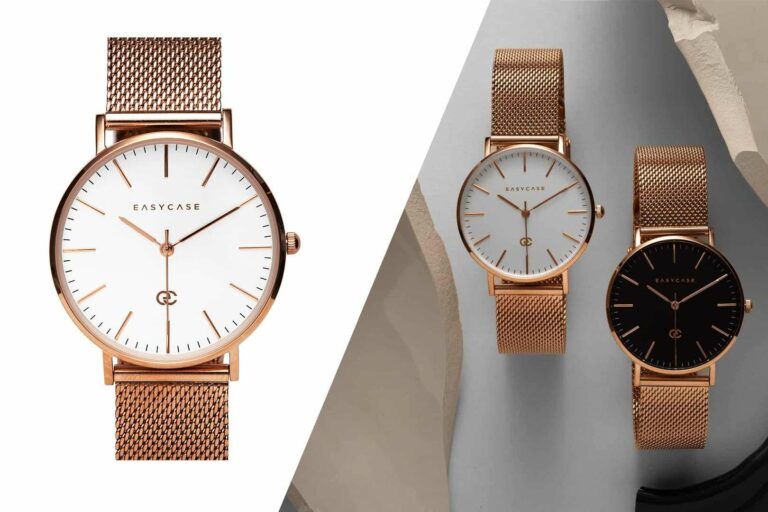
In ecommerce photography, there are three main styles: single shots, group shots, and 360 images. Each has its own advantages and disadvantages.
Catalog / White Background
A white background is perfect for e-commerce photos because it allows the product to be the focus of the photo. With a white background, no additional editing is required to remove distractions from the background. This style also makes it easy to crop and resize photos without losing important details.
On white: individual shots
You just can’t go wrong with a quality individual shot.This type of photography is usually met in website sections with the sole purpose of displaying the product to the customer, nothing more.
The best example would be a catalog. In most cases, product photos for catalogs are usually taken in a studio setting with a white background. It’s simple and it eliminates any extra accessories to help the viewer focus only on the item. However, it’s often necessary to photograph the products in their natural environment.
In these cases, the photographer must be especially attentive to capture all the features and details of the product. For catalogs, the emphasis is primarily on single photos rather than images with two or more objects. This allows the customer to get a closer look at the product they’re about to buy.
On white: grouped shots
Grouped shots are essential for e-commerce websites. Whether you’re selling a bundle of products at a discount price, or just more items at a time, you should be interested to hear more about grouped shots.
Just like in the individual shots, images in the catalog are usually photographed against a white background. This provides a clean, professional look and makes the products the stars of the photo. However, sometimes it can be nice to group some items in an interesting way. This gives customers a better idea of how the products might look together.

Retailers are now starting to experiment with grouped product photos in their catalogs. This can be done in a variety of ways, such as by color, style or type of product. Shooting products in batches also allows customers to get an idea of how the items might be used in everyday life.
Grouped product photos make the catalog more interesting and engaging, and help customers better visualize how the products might fit into their everyday lives.
On white: 360 images
Product photography is about capturing the essence of an item inside an image. This can be done in a number of ways, but one of the most popular techniques is 360 product photography. In this method, the object is captured from all angles against a white background.
One of the many advantages of 360 photography is that it provides a whole new sense of scale and size to your product. It looks as if the item would be moving in front of you, ready to be used. Thanks to this, the viewer gets a complete overview of the product and sees every minute detail in action.
There are several ways to create a 360 photo. One popular method is to use a turntable. The product is placed on the turntable and then photographed from all angles.
Another method is to use a CGI animation. In this case, the photographer creates a 3D model of the product and then uses software to render an animation that shows the product from all angles.
If you use e-commerce to sell luxury items such as jewelry and watches, you will love 360 product photography.
Hero photography style
An effective product photography can make or break a sale. The hero image, in particular, is a powerful way to capture your audience’s attention and focus it on the product. Done correctly, this type of image can be used to create an initial impression and encourage customers to explore the product further.
When creating a hero image, it’s important to consider the angle from which the product will be photographed. This angle should be chosen to best highlight the features and benefits of the product. The lighting should also be carefully considered, as it can play a major role in how your product is perceived.
Ultimately, your goal should be to create an image that leaves a lasting impression on your audience and encourages them to take action. With careful planning and execution, you can create hero images that will help you sell more products.
Hero: minimalistic style
Minimalist product photography is all about simplicity. This type of art is perfect for e-commerce because it focuses on the product and eliminates distracting shadows and highlights.
In addition, minimalist product photography uses simple backgrounds and a limited color palette to create a unified yet stunning look. Because of its simplicity, this type of photography proves to be affordable and easy to implement. Here are some useful tips for you:
- Use or simulate natural light whenever possible, and when shooting indoors, place your subject near a window. The natural light will add a nice softness to your photos.
- Use simple backgrounds with no props. A plain white background is ideal for minimalist photos, but you can also use muted colors or simple textures. Keep accessories to a minimum and make sure they don’t compete with your subject for attention.
- Pay attention to shadows and highlights. In minimalist photography, they are used to create depth and contrast. Make sure these elements work in harmony with each other for the best results.
Hero: with simple props
Start simple. When you begin product photography, it can be helpful to use common objects as props. This way, you can take clean, well-lit pictures with little effort.
Here are some tips for using simple props:
- First, choose a background that matches your product. A plain white backdrop is always a safe choice, but you can also experiment with different colors and textures.
- Use cubes or elevations to create an edge for your product. This will highlight the features of the object and create an interesting composition.
- Experiment with different lighting angles to find the “hero angle” that best shows off your product.
- Use simple objects as props to add interest and texture to your images. Try using books, or even flowers to add visual interest.
Hero: with complex props
Complexity will help you stand out from the competition. When it comes to product photography, props can add a touch of sophistication to the shot. They can make a product look rich and unique, but sometimes they’re less affordable than custom backdrops.
However, there are many ways to take great product photos with more interesting props. Here are some of them:
- The most important thing is that you find props that complement the product well. If the props are too complex or elaborate, they could overshadow the product.
- On the other hand, if the props are too simple or plain, they may not add anything to the shot. It’s also important that the props are proportionate to the product.
- You should also pay attention to how well the props fit the overall theme or style of the photo shoot. For example, if you’re going for a vintage look, you should use vintage props.
Ecommerce photography by device
When launching a marketing campaign for a new product, you need to be aware of the devices on which your photos/videos will appear. As e-commerce becomes more popular, it’s important that your product photos look good regardless of the platform they’re displayed on. Different devices have different screen sizes, so it’s important to crop your photos accordingly.
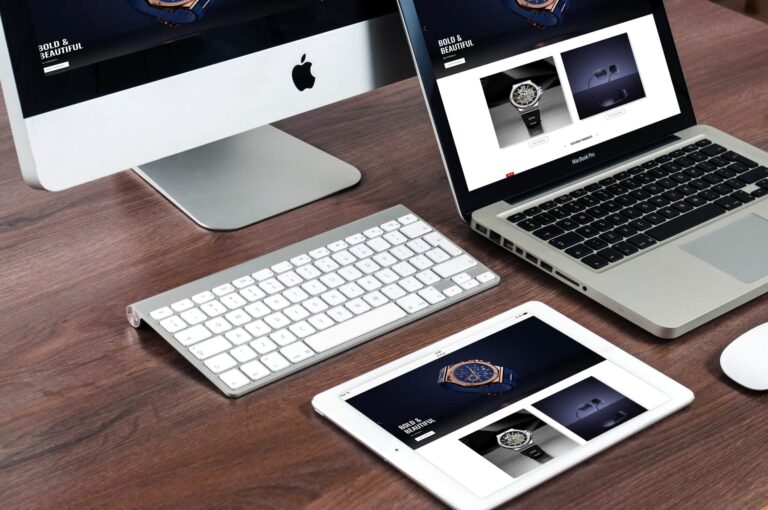
For example, if you’re taking photos of your products on a cell phone, make sure the most important part of the photo is in the center of the screen. This will ensure that the photo looks good on a mobile device. If you’re taking photos with a desktop computer, you can be a little more creative when cropping because you have more space on the screen.
However, one thing remains the same. Regardless of which device you use, it’s important that your product photos are well lit and free of distractions.
Horizontal devices: 16:9 ratio
If most of your clients shop on a desktop, you need to understand this. Image cropping is another important aspect of product photography for an e-commerce website.
When done right, image resizing can help increase sales by presenting products in a way that’s attractive and inviting to customers – it eliminates any flaw from your website, therefore building much-needed trust with viewers. When taking product photos for a website aimed at desktop users, there are a few things to keep in mind:
- Wide desktop screens are still relevant in online shopping. Therefore, it’s important that product images are optimized for 16:9 aspect ratio. This means that photos and videos take up the entire width of the screen, without black bars at the top and bottom.
- You can also make sure your YouTube videos are formatted for 16:9 by selecting “Desktop” as the display option. A website and videos that look good on widescreens will give your viewers a better experience and can even help improve your search engine rankings.
Vertical devices: 9:16 ratio (stories)
Almost half of the population shops with a cell phone. Here’s how to crop your images perfectly to fit their screens. Vertical product photography is becoming increasingly popular, as it has been shown that images taken in this format are more likely to be received positively by social media users and lead to a higher number of views on mobile posts.
Take a look at some key vertical ratio ideas:
- The 9:16 ratio is most commonly used for vertical product photos because it works best for social media and mobile devices. When shooting vertically, it’s important to keep the subject in the center of the image and leave plenty of negative space around the subject. This way, you can ensure that your photo will still look good even if it’s cropped or resized.
- In social media and e-commerce, cropping your image properly is key to telling a good story. On platforms like Instagram and Pinterest, images need to be cropped to a 9:16 ratio to be optimized for the page. This is because images are displayed in a 1:1 square format. If not cropped properly, important visual elements can be cut off or obscured.
- Proper cropping ratio is also important for mobile users. If an image isn’t cropped properly for mobile devices, it may appear distorted or too small on smaller screens. By cropping your images to a 9:16 ratio, you ensure that they look good on any device, regardless of which device they’re viewed on.
Square devices: 1:1 ratio (Instagram)
There’s a new trend in photography that’s all about the square. More specifically, around the 1:1 ratio. This ratio is especially popular on social media platforms like Instagram and mobile e-commerce sites.
Here’s why you should use it for your own photos, too:
- The square image crop is inherently social media friendly. It takes up more screen space, making it ideal for grabbing attention in a crowded newsfeed. The 1:1 ratio is also perfect for Instagram posts and other vertical formats.
- The square crop is ideal for mobile e-commerce because it shows products in their natural proportions. When viewers scroll through a product list, they can see every detail of each item without having to scroll left or right. This makes the shopping experience more user-friendly and eliminates the need to zoom in on product images.
Ecommerce photography by medium
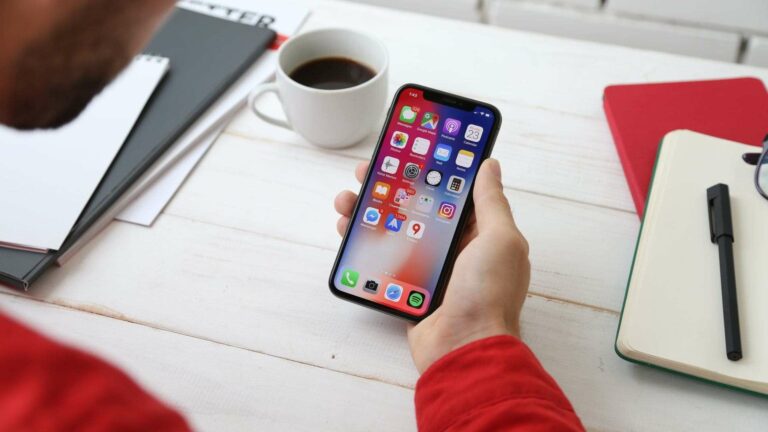
There is no one way to photograph a product. Different application scenarios require different techniques and equipment. Below are some tips for photographing products for e-commerce websites, social media posts, and print ads.
Medium: websites and eshops
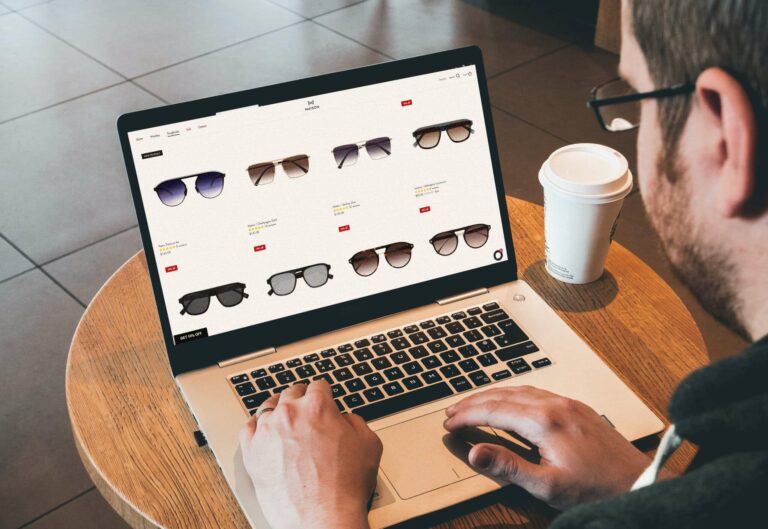
Science says that consumers are visual. According to a study by the Nielsen Norman Group, 90 percent of the information the brain takes in is visual. That’s why product photography is so important for e-commerce websites and e-stores. Good product photos can help you sell your products on social media and in print.
And to sell them faster on your online store, you should keep an eye open for a few things. First, make sure your photos are high quality and bright. Use a good camera and good lighting to capture clear, sharp images. You can also consider a backdrop or studio-like environment for a more professional look.
When photographing products, be sure to capture all angles and features. If possible, show the product in use and take photos from different angles to give customers a good impression of the product.
Medium: social media
Product photography for social media is all about grabbing the attention of your target audience and getting them interested in what you have to offer. You want your photos to be creative and eye-catching, and not look like the same old stock photos everyone else is using. To achieve that, you need to think outside the box and come up with stylized photos that really stand out.

It’s fun to experiment with different props, backgrounds, and light settings when you’re taking product photos. You can also get creative with styling and make your products look interesting from different angles and perspectives. The most important thing is to keep things fresh and interesting so people will want to come back again and again.
If you’re looking for inspiration, check out some of the top brands on social media. Their product photos are always stylish and creative, and they manage to capture the essence of their brand in every image. By copying this type of photography for your own brand, you can create a visual style that is unique and will help you stand out online.
Medium: print
Billboard and print advertising are powerful tools for reaching a mass audience. But how can you best present your product in an image for these media? Resolution is the key.

Images used on billboards and in print media need to be high resolution so they’re clear and easy to read from a distance. If you’re photographing your product for a billboard or print ad, you should use a camera with a higher megapixel count and choose the highest resolution possible. That way, you can make sure your image looks good no matter how far away someone is looking at it.
Did you know?
With CGI product photography, there are no limits to the resolution. That’s because the rendering takes place on a computer and can be increased or decreased as needed. The final image always looks smooth and high-resolution, regardless of the size or complexity of the product.
This makes CGI the ideal solution for catalogs and online stores where customers need to see every detail of the product in print.
Another point to consider when photographing products for posters or print ads is image composition. You should make sure that the image is balanced and that the product is the focus. Use a simple background and avoid clutter so that the product really stands out from the page.
Ecommerce photography by locations

There’s no one way to photograph a product. Different operational scenarios require different techniques and equipment. Here are a few tips for photographing products for e-commerce websites, social media posts and print ads.
Los Angeles, California
If you’re looking for quality e-commerce photography services in Los Angeles is the place for you. With the abundance of experienced photographers, you’re sure to find the perfect one for your needs.
Whether you need product photos or lifestyle images, these professionals can help you showcase your products in the best light. And with a wide range of prices to choose from, you’re sure to find a photographer that fits your budget.
The market for product photographers in Los Angeles is competitive and expensive. There is a wide range of photographers to choose from, each offering their own style and services. However, the high price of hiring a product photographer in LA can be a deterrent for some small businesses.
Nonetheless, Los Angeles is a great market for product photographers due to its large population and wide range of businesses.
Austin, Texas
There are many talented product photographers in Austin, Texas. One of the most notable is Phil Kline. He’s a unique perspective and approach to product photography that sets him apart from the competition. His photos are creative and expressive and really capture the essence of the product.

Another photographer of note is Jeff Wilson. He’s a passion for detail and a knack for getting the perfect shot. Their photos are clean, crisp and beautifully composed.
If you’re looking for quality product photography, be sure to check out the work of these talented Austin, Texas artists!
New York City, NY
If you need a product photographer in New York City, there are many options. But with so many photographers, it can be hard to choose one. You want someone who can capture the essence of your product and show it at its best.
A good place to start is by looking at the photographer’s portfolio. This will give you a good idea of his or her style and skills. Make sure you find a photographer whose experience photographing products because that way you can be sure they know how to capture the details and colors properly.
Another important point you should consider is the photographer’s saturation level. Some photographers prefer a more muted or subtle look, while others prefer a more saturated, eye-catching style. If you’re looking for something that really pops, you should choose a photographer with a high saturation level.
Seattle, Washington
If you need a product photographer in Seattle, Washington, you’ll be happy to hear that there’s a wide range of great options. The city is home to some of the most creative and innovative photographers in the industry, so you’re sure to find someone who can help you present your products in the best light.

A good choice is ND Studio. His work is fresh and creative, and he’s a knack for capturing the essence of his subjects. Whether you’re looking for a simple product photo or something more elaborate, he can definitely help you out.
Another good choice is Artist Eye Studio. Her work is always new and fresh, and she’s a knack for capturing the beauty of her subjects. She’s perfect for products that need to look their best online.
Chicago, Illinois
There’s no question that good product photography is essential for online sales. If you want product photography services in Chicago, A well taken photo can help a customer visualize how a product will look in their home or office, and can be the deciding factor in whether they make a purchase or move on to the next offer.
POW is a Chicago-based company that knows this all too well. For more than 10 years, it’s provided high-quality product photography for businesses of all sizes, from small family-owned businesses to Fortune 500 companies.
What sets POW apart is its team of experienced photographers and photo editors. They know exactly how to capture the essence of a product and make it shine in an image. Whether you need photos for your website, print catalog, or social media campaign, POW can help you create stunning images that drive sales.
Miami, Florida
When choosing a product photography studio in Miami, it’s important to consider what type of products you want to photograph. Not all studios are suitable for all types of products. It’s also important to consider the level of service you expect from the studio.
Some studios only offer basic services, while others offer more comprehensive services like retouching and image editing. If you’re looking for a top-notch product photographer in Miami, Florida, you should contact Etherartsus Studio. The team of experienced photographers can help you shoot the perfect stills for your e-commerce store or catalog.
They have a state-of-the-art studio with the latest equipment and are experts at creating stunning product photos that will make your business stand out from the competition. Contact them to learn more about their services, and inquire about our special rates for Miami businesses.
London, England
When it comes to product photography, London is a European powerhouse. The city is home to some of the best studios and photographers in the industry, making it an ideal location for e-commerce companies looking to capture high-quality product images.
One studio that’s been at the forefront of product photography in London for many years is Lux Studio. The team of experienced photographers has a wealth of experience when it comes to creating stunning product images that will help your business stand out from the competition.
If you’re looking for a high-quality studio with a wide range of products, look no further than Packshot Factory. They have years of experience photographing everything from small objects to large sets, making them the perfect choice for companies with a wide range of products.
Dubai, UAE
E-commerce photography in Dubai is becoming increasingly popular as companies in the United States and the Middle East turn to online platforms to sell their products. Since Dubai is one of the most popular destinations for e-commerce companies, many photographers offer their services there. Many companies are looking for professional photographers to take high-quality pictures of their products to use on their websites and online stores.
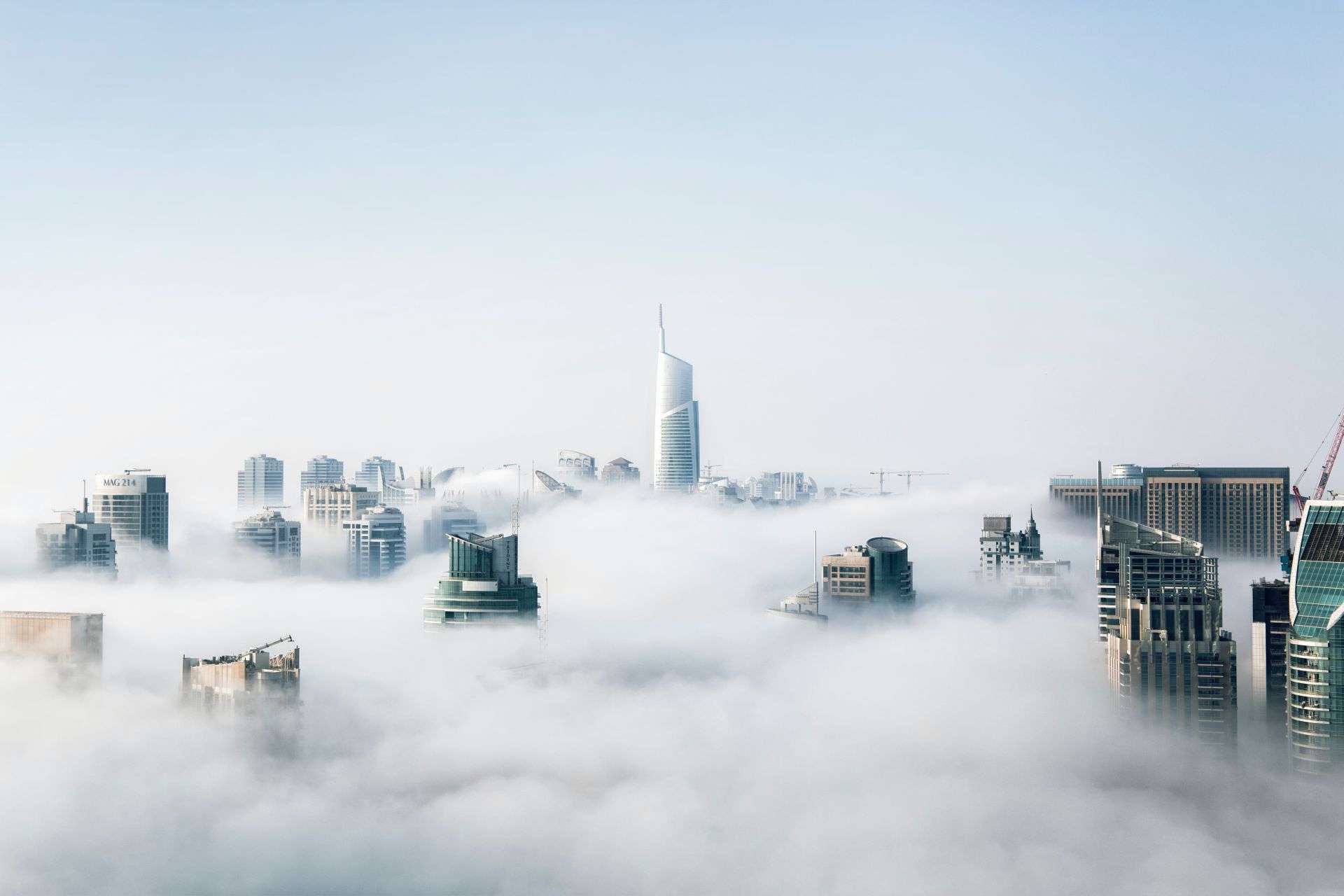
Some studios only offer basic services, while others offer more comprehensive services like retouching and image editing. If you’re looking for a top-notch product photographer in Miami, Florida, you should contact Etherartsus Studio. The team of experienced photographers can help you shoot the perfect stills for your e-commerce store or catalog.
They have a state-of-the-art studio with the latest equipment and are experts at creating stunning product photos that will make your business stand out from the competition. Contact them to learn more about their services, and inquire about our special rates for Miami businesses.
Gear & techiques: traditional photography
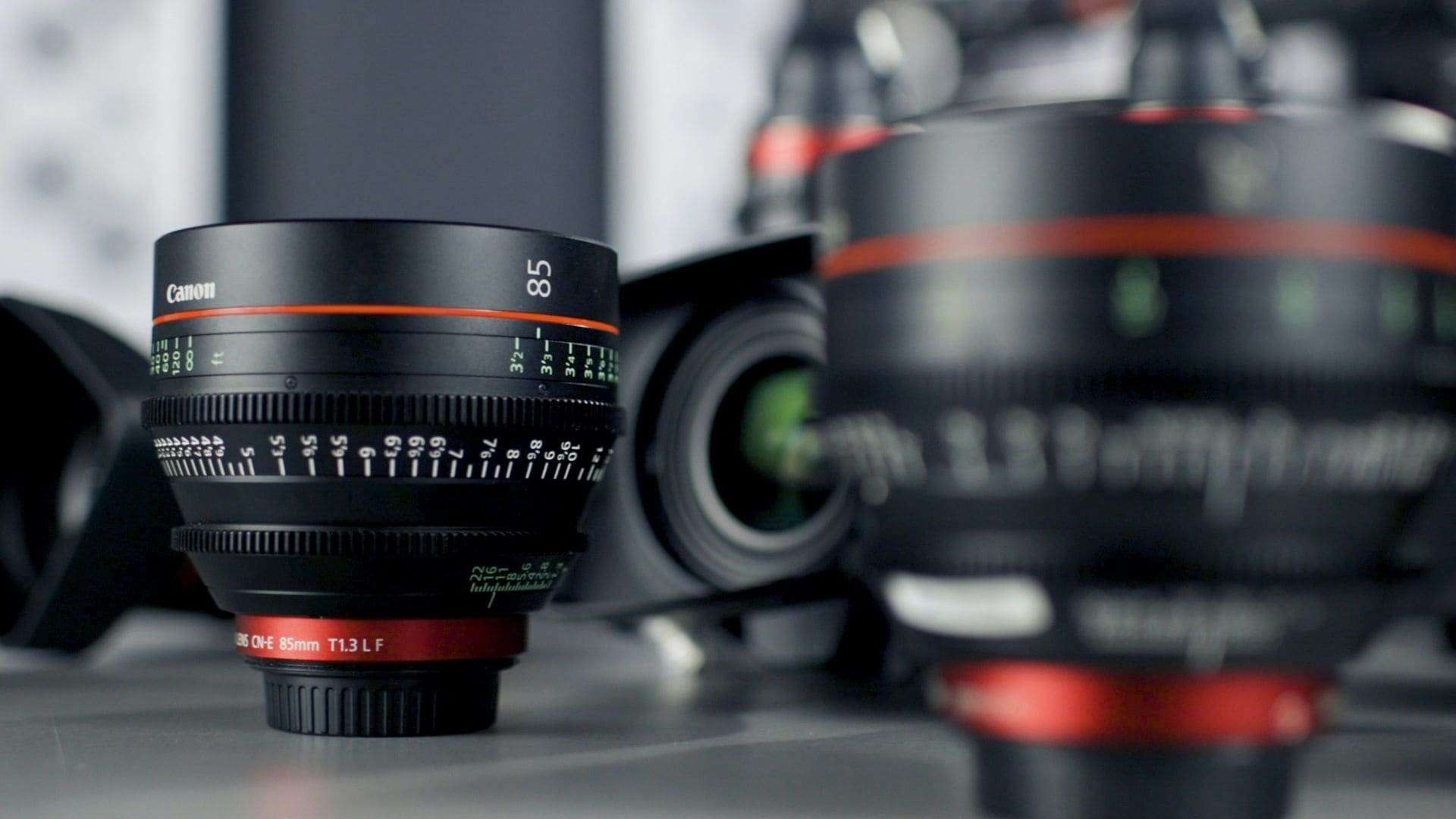
In most cases, the best way to photograph a product is to use a dedicated camera. However, there are a few tools that will make your job easier. Here are some of the best tools for traditional photography:
Gear: camera
Product photography is the main attraction that retains customers on your website. The most important factor is the camera itself, and in the huge ocean of different cameras, you should understand which is best for you and your product photography journey. As is the case in many different areas, some cameras are better than others.
In our opinion, if you’re looking for a camera for product pictures that will give you high-quality images, then a full-frame camera is the best choice. You might ask yourself: “Why those?”. The truth is that details are key in photography, and these cameras offer you just that. They have large sensors that capture more detail than other types of cameras. Also, it’s important that you stay away from distracting factors such as sound. They produce less image noise, which is ideal for product photography. Don’t forget to check watch photography for e-commerce.
Another criterion is the number of megapixels. A higher megapixel count means the image is sharper and more detailed. So if you’re big on quality, you should go for a camera with a high megapixel count.
Gear: camera lens
When it comes to product photography, the right lens is critical. Different lenses offer different focal lengths and depths of field, which can be important for getting the perfect shot. For products, a 100mm lens is a good choice.
It offers a good balance between depth of field and bokeh, so you can get both the product and the background in focus. Plus, 100mm lenses are often inexpensive and easy to find. So if you’re looking for a good lens for product photography, the 100mm lens is a good option for you.
A high- quality lens is especially important for techniques like focus stacking in jewelry photography. When it comes to focus stacking, there’s no one lens that fits all. Different lenses will give different results depending on your needs. However, there are a few lenses that work particularly well for focus stacking.
If you’re looking for a lens that delivers excellent results with minimal distortion, the Nikon 105mm f/2.8VR is a great choice. This lens is perfect for photographing jewelry as it delivers stunningly clear images with incredible detail.
Another good choice for focus stacking is the Canon 100mm f/2.8L Macro IS USM lens. This lens offers great quality and versatility, allowing you to capture both close-up and wide-angle shots with ease. It also features image stabilization technology that minimizes camera shake.
Gear: camera tripod
When choosing the best tripod for product photography, there are a few things to consider. The tripod needs to be sturdy enough to support the weight of your camera and lens, and it should have a smooth-action ball head that allows you to easily adjust the position of your camera. A studio column is also a good option for product photography, as it allows you to raise and lower your camera to find the perfect angle.
A large camera tripod is an important piece of equipment for product photography. It allows you to place the product at a specific location and angle, which can be very helpful for a well-composed photo. There are a few different types of large camera tripods on the market, but my favorite is the studio column from Foba.
This tripod is extremely stable and can support a large amount of weight, making it perfect for photographing heavy products. It’s also height adjustable, so you can position the product at the perfect height for your shot.
When it comes to product photography, a tripod is an essential piece of equipment. But which tripod head should you choose? In this article, we’ll take a look at the Manfrotto Gear Head 405 and learn why it’s a good choice for precision photography.
The 405 gear head is designed for precise camera movements, making it perfect for product photography. It’s two knobs that let you control the tilt and pan of your camera, so you’ve full control over your shots. And thanks to its lightweight, you can easily take it anywhere.
So if you’re looking for a good tripod head for product photography, the Manfrotto Gear Head 405 is a great choice. It’s easy to use, lightweight and allows precise camera movements for perfect shots.
Technique: studio lighting
Studio lighting is an important part of product photography. There are a few things you need to consider when setting up your lighting. Starting off at number 1 is the type of light you are using.
It’s no secret that you can achieve decent illumination in several ways. In our opinion, however, studio strobes are the best choice because they provide an even light and are easy to control. You can also use natural light, but that can be more difficult to manage and vary depending on the time of day.
So now you know what type of light to use, and you think you’re all set to take some amazing pictures. Not so fast! You still have to understand where and how to position your illumination devices. For product photography, it’s usually best to use a direct flash or snoot to direct the light onto the product. You can also use diffusers and filters to soften the light and create certain effects.
The positioning of the light is also important to control shadows.
When you’re photographing products, it’s important to have a nice, soft light that shows off the product to its best advantage. One way to achieve this is to use diffusion plates. Diffusion plates come in all shapes and sizes, but usually consist of thin pieces of paper or fabric attached to a C-stand. This way you can control the direction and intensity of the light.
One of the advantages of diffusion plates is that they produce a very soft light, which is great for photographing products. They can also be used to create an all-around light that’s perfect for shooting small items like jewelry. In addition, diffusing screens help reduce contrast and prevent shadows from forming on your subject.
Technique: natural lighting
If you want to display premium-quality photos that your customers trust, you have to achieve evenly distributed light. This is especially true if you’re shooting against a bright background. Since it can quickly reflect light, your picture can become too overwhelming for the viewer. However, you can easily avoid this with the help of natural light.
One good way to practice introducing natural light into your photo would be to place your product near a window. This way, the sun’s rays can fill in harsh shadows and create an even and convincing photo. If you don’t have a window available, you can use a white reflector to cast the sunlight on your product.
When photographing with natural light, there are 3 main things to keep in mind:
- The first is that you need a window with good lighting. The sun should shine directly on your product to get the best results.
- If you can’t shoot near a window, find an area with as few harsh shadows as possible.
- Too much contrast can make your product look harsh and unnatural.
Window light is the best way to photograph products on a budget. It’s free and creates a nice, soft light. The only problem with using window light is that you can get harsh shadows on the product if you don’t use a reflector. You can use a white piece of paper or cardboard to reflect the light back onto the product and create softer shadows.
Technique: retouching
In the world of commercial product photography, post-processing is everything. After an image is taken, it often needs to be edited and retouched to make sure the product looks its best. This can include removing flaws, adjusting colors, and adding lighting effects.
The most popular software for retouching images in Photoshop. However, you can also get good results using Lightroom and Capture One. All three programs offer a wide range of tools for adjusting photos.
What program you choose depends on your preferences and skills. Photoshop is the most complex program, therefore offering the most flexibility. Lightroom is easier to use, but perhaps not as powerful as Photoshop. Capture One is somewhere in between, offering a good balance between power and simplicity.
Retouching is highly important for your online presence, and there are plenty of reasons why. The most common use for it would be to ensure that your product looks its best. This is especially true for products that are photographed for online sales, as potential customers will look closely at the photos. It can help remove blemishes, fix lighting problems, and make the product look more attractive.
Another reason retouching is important is to ensure accuracy. When you’re photographing a product, it’s important that you capture all the features and details of the product. Retouching can help fill in gaps or correct mistakes that occurred during the shoot. This ensures that the final photo accurately represents the product.
Lastly, you can use retouching to convey moods and feelings to your customers. From colors to the way in which you position your product, you can use image improvement tools to put the viewer in the right mindset to buy any item in your catalog.
Technique: practice
If you want to improve your product photography, you need to start with the basics. It’s important that you understand the functions of your camera and how it works. Once you understand that, you can play with different settings and figure out what works best for the type of photos you want to take. Experimentation is an important part of the process, so don’t be afraid to try new things.
One thing that can help you is using photo editing software to enhance your shots. Sometimes they don’t turn out the way you hoped they’d. In this case, software like Photoshop can be very helpful. Also, make sure your product photos are well lit – this will make your shots look much more professional and polished right away.
And finally, practice makes perfect! The more you take photos, the better you will get at it.
Tools & techniques: CGI photography
CGI photography is a great way to create unique and interesting images. However, without the right tools, it can be difficult to get started. In this article, we’ll take a look at some of the best tools for CGI photography. In this section, we’ll take a look at some of the best of them.
Tool: reference images
Reference images are a key element of successful product photography. They serve as a visual reference for the CGI artist who creates the final image. Reference images can be anything from a simple photo of the product to a complex 3D rendering – you can use whatever you want, depending on the complexity of the project. The more accurate the reference image is, however, the better the final image will be.
The process of creating computer-generated imagery (CGI) begins with taking reference images. This step may seem obvious, but it’s important to get the details right so the final product looks realistic.
There are a few things to keep in mind when capturing reference images. First, you need to make sure the lighting is right. If you want to create a realistic image, you need to recreate the lighting conditions as best you can. Second, pay attention to the details.
Make sure you get all the little details right, from the texture of the objects to the shadows they cast. Third, take lots of photos. You may not get everything perfect on the first try. That’s why it’s helpful to have several reference images to help you achieve your goal.
Tool: mood boards and inspirations
Mood boards, also called inspiration boards, are a visual representation of the look and feel you’re going for in your project. They can be used for everything from product photography to product design.

A mood board can be as simple or as complex as you want it to be. Usually, they consist of images cut out of magazines, photos from the internet, or even sketches. The important thing is that the images on the board look the way you envision your final product.
Mood boards can be a great way to get inspiration for a project. Sometimes it’s hard to know where to start, but looking at other people’s work can give you some ideas. It’s also a good way to see what looks good and what doesn’t.
A CGI moodboard is especially useful for CGI product photography. A moodboard is a great way to get inspired and try out different ideas before you start working on your project.
Tool: 3D software
If you’re creating CGI product photography, the right software can make all the difference. 3D modeling and rendering software can help you create realistic images of your products, with accurate lighting and textures.
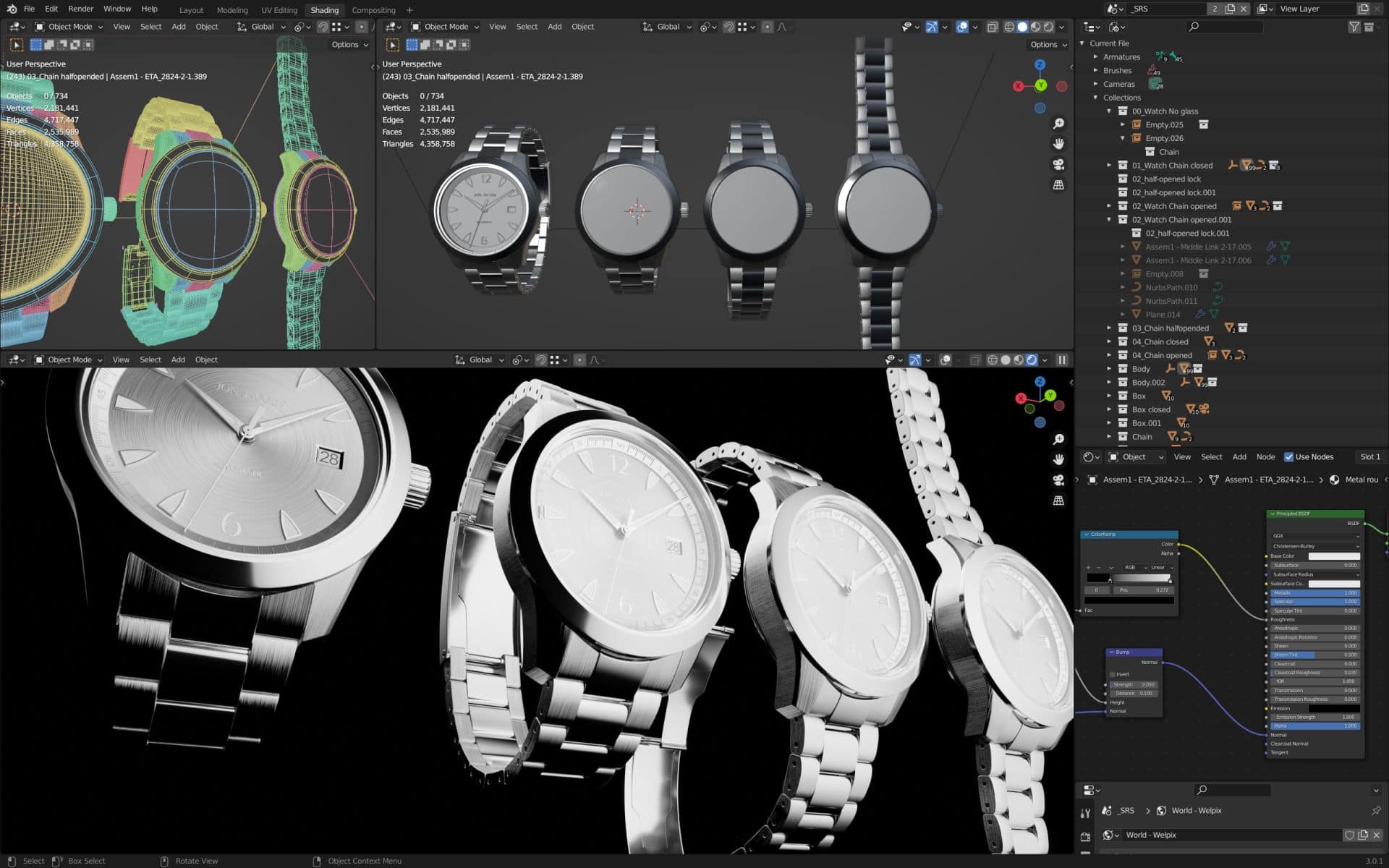
Here are some of the best options for CGI product photography:
- Cinema 4D is a popular choice for 3D modeling and rendering. It’s easy to use and has a wide range of features that make it suitable for a variety of projects.
- Blender is another powerful 3D modeling program that’s free to download and use. It’s a large community of users who share tips and tutorials to help you get started quickly.
- 3ds Max is a professional 3D modeling and rendering package used in many Hollywood movies.
Tool: hardware
If you want to create CGI product photographs, you need special hardware. A high-end graphics card is a must, as it’s responsible for rendering the 3D models.
A good graphics card will allow you to work with large files and quickly create realistic images. The NVIDIA 3090ti is a good choice, as it can handle even the most demanding tasks. You’ll also need plenty of RAM (100 GB is recommended) and a fast processor. A powerful workstation PC can be expensive, but it’s definitely worth the investment if you’re serious about CGI product photography.
A large monitor is also important so you can see the results of your work right away. With the right hardware, you can produce beautiful CGI product photos that look so real they fool the eye.
Techniqe: skill
There are many skills necessary to be successful in CGI product photography. Perhaps the most important is the ability to learn quickly. New software and techniques are constantly being developed, and the photographer must be able to keep up with these changes to create realistic images.
Lighting is the key to success when you’re photographing products – whether they’re physical or digital. It’s important to get the lighting just right to capture the product in the best light (pun intended). That way, you can create realistic images of products that look like they’re actually being photographed.
Patience is also important, as creating high-quality CGI product images can be a time-consuming process. The photographer must also have good visualization skills and an eye for detail.
Persistence is another important requirement, as you may need to try a few different techniques before you find one that works for you.
Anyone with the right skills can take great product photos. When it comes to CGI product photography, however, the right skills are only part of the equation. You also need patience and time to get the results you want.
With the right skills and experience, you can create beautiful, high-quality product images for your clients – no matter what kind of product they sell.
Techniqe: teamwork
In the world of CGI product photography, teamwork is key. Working with a team of experts can result in stunning product images that look like they were shot in a studio. Collaboration between photographers, CGI artists, and retouchers can create a seamless image that looks realistic and eye-catching.
CGI product photography requires a high level of skill and coordination. The photographer must have an understanding of lighting and composition, while the CGI artist must be able to use software to create realistic images. The retoucher is responsible for making sure the final image looks perfect and that all the details are correct. When they work together as a team, they can create beautiful and accurate images that impress clients and customers.
Hiring a professional ecommerce photographer

If you want to create a professional and polished e-commerce store, one of the most important steps is to hire a professional e-commerce photographer. He can help you take the best pictures of your products and create a look that will make your store stand out from the competition. Here are some tips on how to find and hire a good e-commerce photographer:
1. Do your research. There are many photographers out there, so take the time to find one who specializes in photographing products for e-commerce stores. Check out his portfolio and make sure his style fits your vision.
2. Ask for references. Once you’ve narrowed down your choices, ask for references from previous clients. This way you can get an idea of their work and find out if they’re easy to work with.
Search for studios
If you’re looking for a professional photographer to take product photos for your business, you’ve several options. You can look for a studio that specializes in still photography, or you can find a CGI studio that does product photography.
Both still life photographers and CGI studios can take high-quality, professional photos of your products. However, there are some differences between the two types of photography studios.

Still life photographers tend to have more experience photographing objects in a studio setting. They can also choose from more props and backgrounds, which can lead to more interesting and visually appealing photos.
CGI studios specialize in creating realistic 3D images of products. This can be especially useful for companies that sell products online, as it allows customers to see how the product will look from all angles.
Product photography prices
If you’re in the market for quality product photography, you’ll probably find that prices vary widely from photographer to photographer. To get an accurate estimate for your project, you’ll need to consider a few factors: the scope of the project, the number of images needed, and the amount of retouching required.
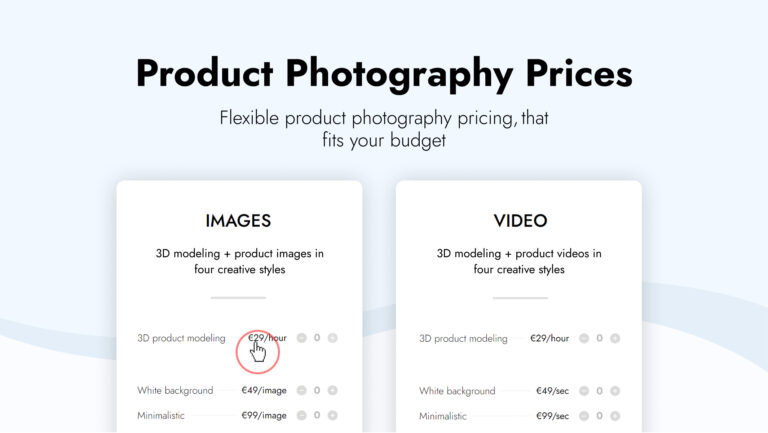
Generally, the cost for simple product photography starts at about $50 per image on a white background. However, if you need special lighting or a complicated background, the price can be significantly higher. Also, if you need extensive retouching or color correction, your bill can easily exceed $100 per image.
It’s important to keep these things in mind when budgeting for product photography. If you know what’s involved in each shoot, you can better estimate how much you’ll need to spend.
Final thoughts
In summary, e-commerce businesses should consider product photography as an important aspect of their marketing strategy.
Professional photos can have a huge impact on the success of an online store, and there are many ways to improve product photography without breaking the budget – when done right, product photography can skyrocket your return on investment!
FAQs
What is eCommerce photography?
eCommerce photography is the creation of high-quality images and videos of products for online stores, aimed at showcasing their features, size, color, and texture in detail and to increase sales.
What are the two types of photography for eCommerce?
The two main types of eCommerce photography are product photography and lifestyle photography. Product photography focuses on detailed, accurate images of a single product, while lifestyle photography showcases products in use in a creative and dynamic way.
Why is eCommerce photography important?
eCommerce photography is important because it builds trust with customers, enhances the shopping experience, increases sales, sets your business apart, and facilitates product comparison. It is crucial for businesses that sell products online and is an investment in their success.
